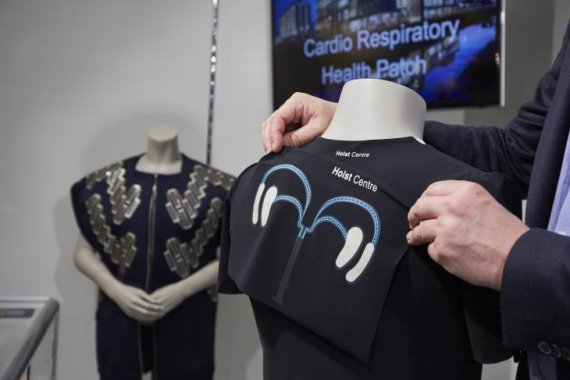
The term ‘electroluminescence’ doesn’t cross the lips of a sporting goods manufacturer easily. This made it all more important for the sports industry and the printed electronics experts to come together. In a cooperation project, Messe München combined the two sectors to stimulate innovation and bundle creative energies. The two trade fairs ISPO and LOPEC are the resonators of these mutual oscillations. This is an extremely important meeting, as it opens up new markets for printed electronics and connects the sports industry to an important future field. This results in real innovations.
It’s about complementing each other’s value chains
Innovative processes like this aren’t just about quick impulses. In order to achieve real added value, value chains must be closely monitored and synchronized. A research project at the Chair of Innovation Management at Zeppelin University examined these innovation processes in more detail. The result: The processes essentially work in two directions. On the one hand, solutions from external value chains can be integrated into your own process, the outside-in process. On the other hand, your own approaches can be integrated into outside processes, whereby the study speaks of an inside-out approach. An actual state analysis helps to analyze mutual structures and thus select suitable target industries. The possibilities for cooperation range from loose collaboration in the sense of a service provider relationship up to the development of joint business models. The latter form of cooperation can be very promising, as the risks are also shared in addition to the opportunities, thus creating a higher mutual commitment. In addition, close forms of cooperation also make it possible to bundle competences that are more remote from development, for example in purchasing or in marketing and sales.
Cross-industry needs a curator
As is often the case, in many places fruitful potentials are lost because there is no clear responsibility in the companies concerned. Although they have been established, those responsible often don’t see the forest for the trees. A cross-industry approach can effectively combine nearly all industries. Hardly any scenario is too crazy to be considered at all. What companies therefore need as an initiation in the overarching innovation process is a curator whose insights and contacts extend into various industries. This above all requires breadth and clarity, as the companies themselves bring in-depth specialist knowledge with them. It’s more about getting the ball rolling, opening your mind, and establishing a concrete vision of cooperation. This curator can be a trade fair, as seen in the examples of LOPEC and ISPO. Traditionally, trade fair companies have a very heterogeneous industry portfolio and good contacts in the individual industrial sectors. The stronger and more diverse the corporate landscape in the respective region, the higher the innovative potential.
“Technology is the most important driver of the sports industry”
Especially in the sports industry, cooperation with non-subject industries can mean real leaps in dimensions. On the one hand, new technologies play an important role in the depth of innovation, as Prof. Andreas Hohmann knows. He maintains the Chair of Sports Technology at the University of Bayreuth. “Immediately after a new sport or product group has established itself on the market, manufacturers will start competing for the best material, the most sophisticated technology, or the most aerodynamic design. Non-specialist technologies and materials can be a decisive competitive advantage here.” Beyond that, of course, there’s also competition for customers. But these days that isn’t a primarily intra-industry, it’s cross-sector. “The customer doesn’t really care whether a fitness application comes from a technology provider like Google or is launched by a sports brand like Nike. What’s crucial is who’s present on the market first. If the sports industry doesn’t open itself up here and isn’t prepared to integrate outside-industry technologies, the entire industry will miss the connection to the consumers of tomorrow.”
The outdoor industry has recognized the signs
The outdoor sector is often considered to be a closed-off sector. The LOPEC Cross-Industry Walk showed that this impression isn’t true. With representatives for international outdoor brands such as Amer Sports, Deuter, Jack Wolfskin, Mammut, Marmot, Ortovox, Schwan Stabilo Outdoor, and Vaude, the cross-industry format was of extremely top quality. In addition, higher-level industry representatives from the European Outdoor Group took part in the event and were actively searching for points of contact. Together, they seized the opportunity to approach an outside industry as a united front and to allow in new ideas.

 Sports BusinessSki Mountaineering Goes Olympic: What Milano-Cortina 2026 Means
Sports BusinessSki Mountaineering Goes Olympic: What Milano-Cortina 2026 Means
- ISPO awards
- Mountain sports
- Bike
- Design
- Retail
- Fitness
- Health
- ISPO Job Market
- ISPO Munich
- ISPO Shanghai
- Running
- Brands
- Sustainability
- Olympia
- OutDoor
- Promotion
- Sports Business
- ISPO Textrends
- Triathlon
- Water sports
- Winter sports
- eSports
- SportsTech
- OutDoor by ISPO
- Heroes
- Transformation
- Sport Fashion
- Urban Culture
- Challenges of a CEO
- Trade fairs
- Sports
- Find the Balance
- Product reviews
- Newsletter Exclusive Area
- Magazine



